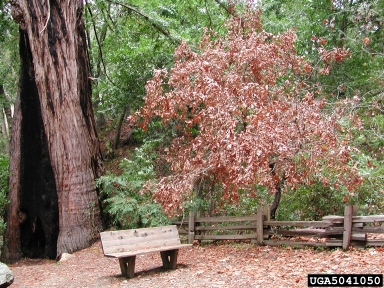|
Fire and Invasive Species
Invasives species present a profound threat to ecosystems by displacing native species directly and by altering the processes that have sustained forests over the long term. Invasive plants, wildlife and pathogens are a growing problem across the coast redwood range, and their spread can be affected by disturbances like fire. Once established, some invasives have the potential to alter the spread or behavior of future fires.
Because of their novelty in the ecosystem, we don't know as much about the threats posed by invasives as we would like to. Forest managers have struggled with invasive plants in clearcuts for decades, and in areas managed for wood production, some of the most problematic weeds are managed by waiting for forest canopies to close and for litter and duff to seal the bare mineral substrate that most weeds prefer for establishment. Sustained fire use in these areas can be challenging, however, because trees are often killed and mineral soil is repeatedly exposed. Most old growth coast redwood forests on slopes have a shrub understory and canopies between 60 and 80 percent. With surface fires, these light conditions may be sufficient for the establishment and spread of numerous undesired plants, particularly in remote portions of parks and reserves where monitoring is infrequent.
Sudden Oak Death
 The greatest invasive threat to the integrity of North Coast redwood forests results from the pathogen that causes Sudden Oak Death (Phytophthora ramorum). The greatest invasive threat to the integrity of North Coast redwood forests results from the pathogen that causes Sudden Oak Death (Phytophthora ramorum).
Tanoak (Lithocarpus densiflorus) is particularly susceptible to this disease, and given its importance in the lower canopies of most upland forests its loss will radically alter competitive dynamics, increase coarse woody fuel loads, alter surface fire weather conditions and fire behavior, and remove an important food source for wildlife. Because of these likely effects, Sudden Oak Death should not be seen as a typical forest disturbance; it promises to bring a profound and essentially permanent change to the coast redwood landscape.
Jubata Grass
Jubata grass (Cortaderia jubata) and Selloana grass (Cortaderia selloana) are native to the mountains of South America. They were introduced decades ago for their ornamental value, then quickly escaped to disturbed areas. The hundreds of thousands of lightweight seeds produced annually by an individual plant can spread for kilometers. Largely because of this remarkable adaptation for dispersal, young clearcuts across the North Coast and many naturally disturbed areas have become dominated by one or both species.
Five years after the 2003 Canoe fire, Cortaderia had established across a surprising range of sites. Prior to the fire, scattered populations occurred along road corridors and clearcuts outside the burn area and in a large landslide along Canoe Creek near the center of the burn. Five years after the fire, new populations are actively establishing under the deadened canopies of upland Douglas fir forests that had burned severely and to a much less degree under more closed canopy. Decades earlier, the upland fir forests that burned severely in 2003 had invaded upland prairies as a result of livestock grazing and fire exclusion. By the time of the fire, these dense stands had formed a thick layer of duff and litter under their closed canopies, typically 5-10 cm thick. When this ground and canopy cover was lost in the fire, aggressive non-native grasses and weeds had no competition for the bare, sunny substrate except for each other. Douglas fir and Pacific madrone seedlings are now present, but forest regrowth is inconsistent with a prairie restoration objective.
If the invasive Cortaderia was restricted to these scattered areas where Douglas fir had invaded the prairies and then burned severely, this new problem would be containable. Most prairies occur on the watershed divides and have good road and trail access. However, establishment also has occurred downslope within small and large gaps of the Douglas fir-redwood forest type. These gaps maintain intact understories consisting of dense resprouting tanoak and huckleberry. This suggests that Cortaderia can readily establish under moderate light conditions and with sprouting shrub understories years after the fire has passed. Of note, a few grass seedlings were even found in surveys of unlogged alluvial flats where litter accumulation is uniform and exceeds 2 cm in depth. Given the prevalence of gaps in old growth and second growth upland forests, the long-term potential for Cortaderia establishment in the park remains an open question.
Due to the natural openness of redwood-Douglas fir forests, the imminent loss of tanoak due to Sudden Oak Death, and the elevated wildfire risk due to increased fuel and possibly climate change, forest canopies may never close enough to shade out this invasive completely. With repeated fires, cover could feasibly achieve 20% on some sites by the end of the century and subsume much of the competitive role currently held by huckleberry. Like huckleberry, dense patches of Cortaderia will compete with tree seedling establishment, leading to feedbacks as older trees that die are more slowly replaced due to slower sapling growth and failed establishment. Fortuntately however, the prevalence of sprouting in coast redwood should ensure that it maintains its importance in stands over coming centuries.
Might fire regimes change with increased cover of Cortaderia in the more open upland forests of Humboldt Redwoods State Park? Cortaderia species have a high silica content, and it is unclear how it might burn when mixed among dense huckleberries. It is thought to be less flammable than most other grasses, but it could easily alter fire behavior.
The increased competition provided by this invasive can reduce or preclude fir or redwood seed establishment. This is of concern because of the imminent loss of mid-story tanoak and the historically moderate fire behavior associated with hardwood litter. Increased understory grass cover may alter small mammal populations and could reduce the quality of foraging habitat for sensitive species such as the Northern Spotted Owl.
Related Pages:
Steve Norman
|
|



